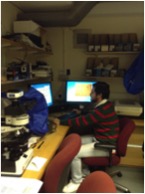
João Casaca Carreira, Netherlands
PhD student, Maastricht University
From 4 – 24 October 2015, I spent time in the lab from Prof. Trevor Sharp, Department of Pharmacology, University of Oxford.
During these 3 weeks, I could meet and learn from 3 researchers working on different projects using DREADD:
Expression of DREADD in the Dorsal Raphe Nucleus: from this project and researcher I was able to learn the technical details of the DREADD approach, like surgical techniques in detail (injection needles used to target small structures, volumes of virus injected and direct relation with expression of DREADD, time for infection and expression, etc.);
Effects of CNO (clozapine-N-oxide) – the inert ligand that activates the DREADD in mice. This project was in the analyses phase, so was possible to observe and learn how DREADD expression can be quantified in several brain regions using microscopy techniques and software ;
Expression of DREADD in the hippocampus and frontal cortex and possible cognitive effects. This project is in a planning phase, so all the surgical details, behavioural tests, readout parameters and schedules/budgets are being produced and discussed.
During my stay, I had the opportunity to visit the facilities and assist some surgeries where DREADD techniques were applied: stereotaxic surgery, intracranial injection, electrophysiological recordings. Moreover, I was able to see some tissue sections and stainings from animals where DREADD was expressed. These sections were analyzed with microscopy techniques, which I was able to see and learn how to quantify.
During one of the labmeetings from Prof. Sharp’s group I was able to show some of our recent data on the exon skipping approach in the mouse model of Huntington’s disease. I received some valuable feedback and some ideas on how to apply DREADD technology in the scope of Antisense-Oligonucleotides approach.
In conclusion, these 3 weeks of short-term scientific mission were extremely informative and crucial to learn the practical details about the application of DREADD approach in vivo. At this stage is possible to say that we will collaborate in a very near future.
October 2015
